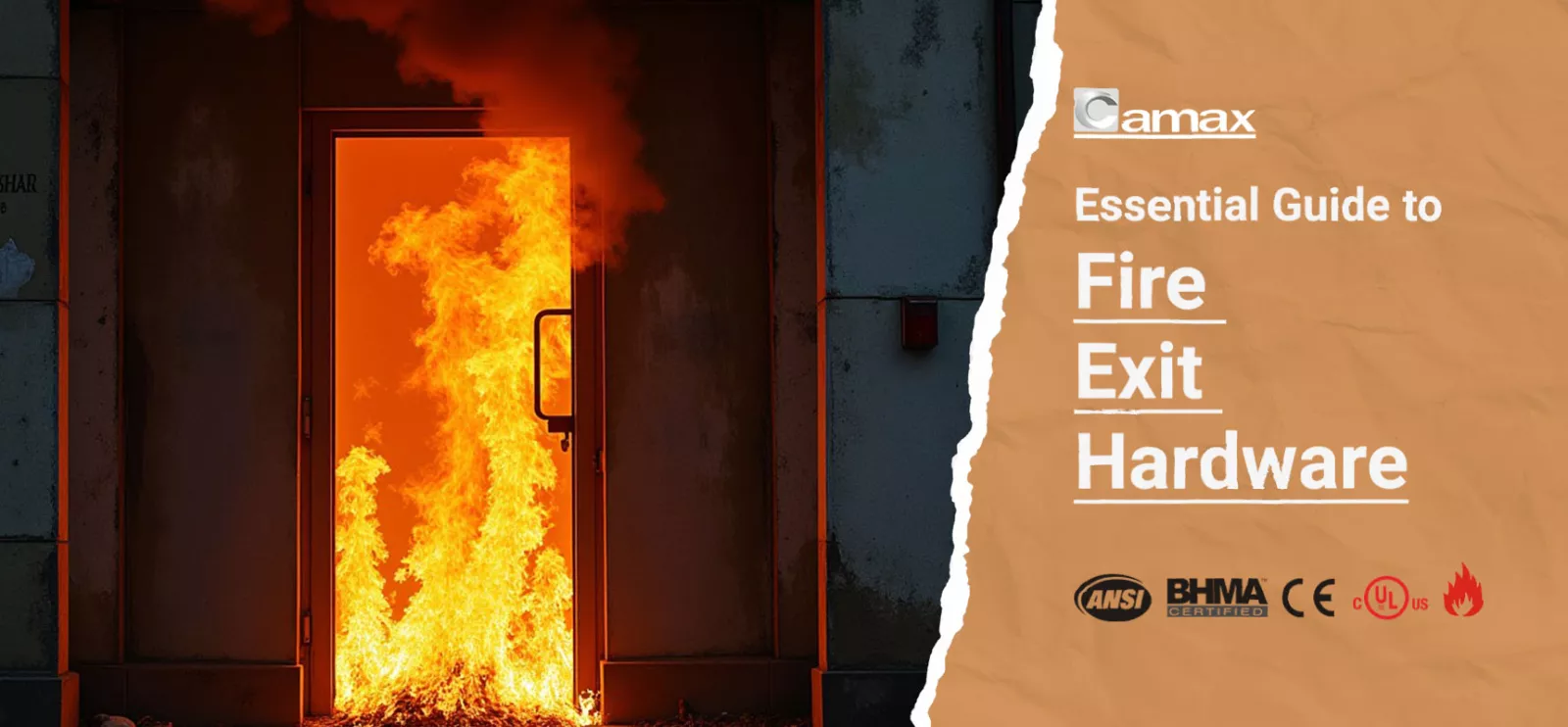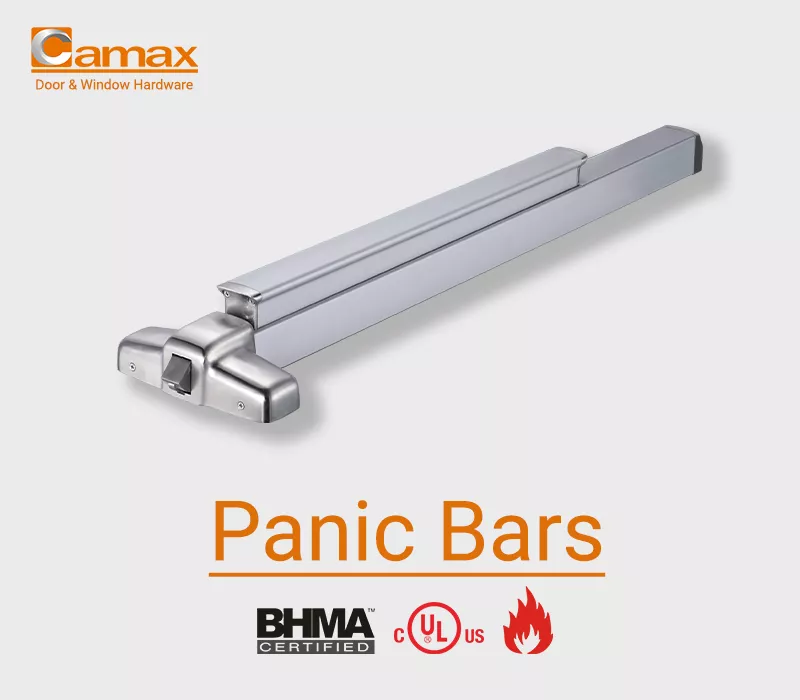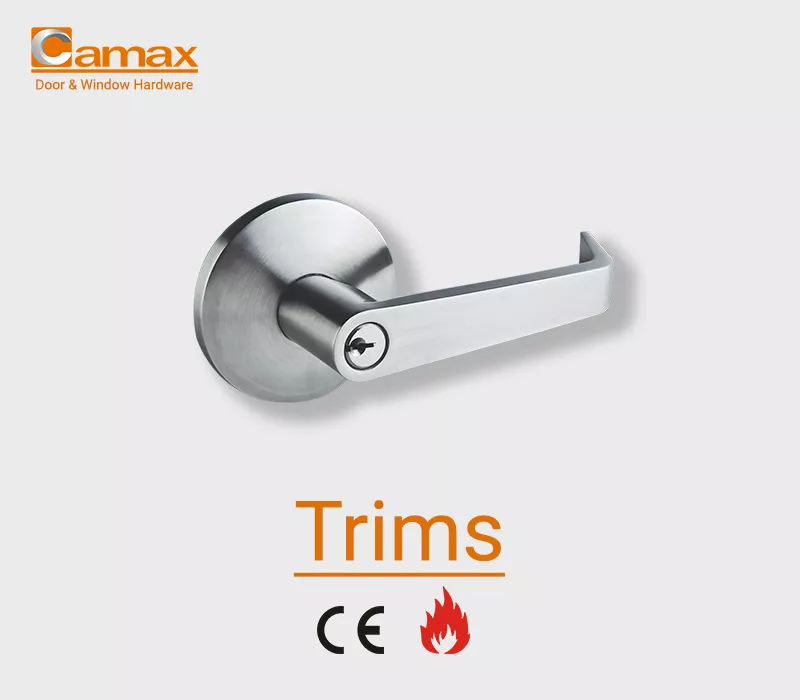
Fire exit hardware is the backbone of building safety, designed to facilitate safe evacuation during emergencies while ensuring the structural integrity of fire-rated doors. Its dual role in providing secure egress and maintaining fire containment makes it indispensable in commercial and public spaces. In this comprehensive guide, we’ll delve into what fire exit hardware is, how it differs from panic hardware, its functionality, types, and regulatory standards.
What Is Fire Exit Hardware?
Fire exit hardware is a specially engineered door mechanism installed on fire-rated doors. Its primary function is to provide quick, effortless egress during emergencies like fires while ensuring the door remains a barrier against fire and smoke.
Ease of Use: Operable with a push or pull, allowing quick exit in high-stress situations.
Fire Resistance: Maintains integrity under extreme heat, adhering to fire safety standards.
Automatic Relocking: Ensures the door re-secures itself after operation to continue functioning as a fire barrier.
Durability: Designed to endure frequent use and challenging environments.
Fire exit hardware is essential in stairwells, hallways, and other emergency exits, ensuring safety for occupants in commercial, residential, and industrial buildings.
Differences Between Panic Hardware and Fire Exit Hardware
Although both panic and fire exit hardware aim to ensure safe evacuation, they serve distinct purposes and are installed in different scenarios:
Panic Hardware
Designed for a door which needs a panic hardware.
With dogging features.
Enables quick egress during emergencies like crowd rushes or accidents.
Frequently used in spaces like theaters, schools, and shopping malls.
Fire Exit Hardware
Specifically installed on fire-rated doors.
Without mechanical dogging.
Combines easy egress with the ability to maintain fire and smoke barriers.
Required in high-risk areas such as stairwell exits and fire escape routes.

In summary, while panic hardware prioritizes egress speed, fire exit hardware also ensures fire containment, meeting strict safety regulations.
How Does Fire Exit Hardware Work?
The functionality of fire exit hardware is centered on its straightforward design and dependable operation. These systems allow doors to open with minimal effort, typically through a horizontal push bar or lever mechanism, ensuring quick access in emergencies. Once used, the hardware automatically relatches to maintain its role as a fire barrier, supporting building safety protocols.
Constructed with heat-resistant materials, the hardware remains operational even under extreme temperatures, providing a reliable escape route. Additionally, many systems are compatible with fire alarm integrations, enabling automatic door unlocking during critical situations. Together, these features guarantee effective evacuation and sustained fire protection, saving lives and minimizing property damage.
Types of Fire Exit Hardware
Fire exit hardware is essential for ensuring safe and efficient evacuations in buildings, offering various solutions to meet the specific needs of different door types and environments. Here are some common types of fire exit hardware, each designed to provide reliable safety and functionality.
1. Push Bars and Panic Bars
Push bars and panic bars are designed to allow quick, effortless exit in emergency situations. These devices are incredibly simple and intuitive to use, requiring minimal force to open the door. Often found in high-traffic areas such as malls, hospitals, and public buildings, push bars and panic bars are critical for ensuring that large numbers of people can evacuate quickly during a fire or other emergency. These bars meet the standards of fire safety codes, ensuring that occupants can escape without being hindered by complicated locking mechanisms. The straightforward nature of these bars makes that these fire exit locks for doors are ideal for locations with heavy foot traffic and the need for a fast response.
2. Mortise Locks
Mortise locks are embedded directly into the door, providing a secure and discreet locking solution. They offer enhanced security alongside fire resistance, making them an excellent choice for areas where both safety and security are paramount. Common in commercial buildings and industrial settings, mortise locks provide a durable locking mechanism that prevents unauthorized access while ensuring the door remains fire-rated. This fire exit door lock is ideal for high-security applications, such as office buildings, government facilities, and residential buildings that require extra security measures, while also providing the necessary protection during a fire.
3. Lever Handles and Trims
Lever handles and trims combine functionality with aesthetic appeal, offering a stylish yet practical solution for fire exits. These handles are often used in combination with push bars or panic bars to provide a complete fire exit system that meets both safety and design requirements. Lever handles are easy to operate, providing comfort and ease of use while maintaining compliance with fire safety standards. They are commonly found in hotels, office buildings, and high-end residential properties where design considerations are as important as safety features.
4. Cylindrical Locks
Cylindrical locks are one of the most cost-effective and easy-to-install options for fire-rated doors. These locks are commonly used on doors with moderate fire-rating requirements and are ideal for areas where budget constraints are a consideration without compromising on safety. Cylindrical locks are designed to provide a secure closure and are often used in commercial or residential buildings where security and fire safety need to be balanced efficiently. Their straightforward design makes them a popular choice for contractors looking for reliable and affordable fire exit solutions.
5. Door Closers
Door closers are crucial in maintaining the fire containment capabilities of a building. These devices automatically close the door after use, ensuring that it remains shut and prevents the spread of smoke and fire. By maintaining a tight seal, door closers help to compartmentalize fire and smoke, protecting escape routes and minimizing the damage to other areas of the building. This type of hardware is essential in buildings that require continuous fire safety measures, such as hospitals, schools, and hotels. Door closers work alongside other fire exit hardware to ensure that the door remains in place during an emergency, enhancing overall fire protection.
Each of these fire exit hardware types serves a specific function and is tailored to meet the needs of various building types. Architects and contractors can select the appropriate hardware based on the level of fire resistance, security, and ease of use required for a given space. With the right combination of hardware, buildings can be designed to maximize safety and ensure the protection of all occupants in case of an emergency.
Building Codes and Standards for Fire Exit Hardware
Adhering to international standards is critical for ensuring that fire exit hardware functions as intended during emergencies. These standards help ensure that the hardware can withstand extreme conditions, provide quick and easy access, and effectively contribute to the safety and protection of building occupants. Compliance with these standards assures that fire exit hardware will operate reliably when it is needed most.
There are several important certifications that fire exit hardware should meet to ensure quality and reliability. These include:
UL (Underwriters Laboratories): UL certification is widely recognized, particularly in the United States. It ensures that the fire exit hardware can withstand intense heat and remain functional during a fire, preventing failure that could compromise safety. UL-rated devices are tested for fire resistance, structural integrity, and performance during emergencies.
CE Marking: The CE mark signifies compliance with European Union regulations, ensuring that fire exit hardware meets EU safety, health, and environmental requirements. CE marking covers the hardware's performance under fire conditions, helping architects and contractors ensure that the equipment is safe for use across the European market.
ANSI (American National Standards Institute): ANSI standards are crucial for ensuring that fire exit hardware meets the highest safety benchmarks in the U.S. These standards focus on performance under stress, particularly in terms of how hardware operates during emergency evacuations.
BHMA (Builders Hardware Manufacturers Association): BHMA certification guarantees that the fire exit hardware meets or exceeds the rigorous standards for quality, performance, and safety required for commercial applications in the U.S. BHMA-rated products are tested for both durability and reliability in fire conditions.
Each of these certifications ensures that fire exit hardware will function effectively during emergencies, keeping occupants safe while complying with local building codes and international safety regulations. By choosing door hardware and emergency door locks with these certifications, architects, contractors, and property owners can be confident that their fire exit systems are up to the task of protecting lives and property.
Why Choose Camax Hardware for Fire Exit Hardware?
Camax Hardware is a trusted leader in fire exit hardware, with nearly 20 years of experience in delivering reliable, high-quality solutions that meet global safety standards. The company’s products are certified by key international organizations such as UL, CE, ANSI, and BHMA, ensuring compliance with the highest fire safety regulations.
Camax Hardware specializes in a range of fire-rated solutions, including panic bars, mortise locks, lever handles, and door closers, all engineered for both safety and functionality. Each product undergoes rigorous testing in-house, supported by their ISO 9001 certification, guaranteeing durability and top-tier performance in critical situations.
Camax Hardware’s offerings cater to a wide range of applications, from high-security commercial buildings to residential spaces. Their fire exit solutions are designed to ensure fast, efficient exits in emergencies, maintaining fire containment and safety. Notably, the company’s fire-rated panic bars can endure heat for up to three hours, providing peace of mind during an emergency. Lever handles and mortise locks from Camax Hardware blend aesthetic appeal with robust safety features, meeting both EN1906 and UL standards.
With a global reputation for excellence, Camax Hardware continues to be the preferred choice for architects, contractors, and building owners seeking reliable, certified fire exit hardware. Their comprehensive product range offers safety without compromise.
Conclusion
Fire exit hardware is a cornerstone of building safety, enabling rapid evacuation while preserving fire containment. Understanding its types, functionality, and regulatory standards helps stakeholders make informed decisions for their projects.
For certified, high-quality fire exit hardware, Camax Hardware is your ideal partner. With a proven track record, advanced manufacturing capabilities, and global certifications, Camax Hardware delivers products that prioritize safety and reliability. Contact Camax today to explore our range and discover how we can support your project needs.






